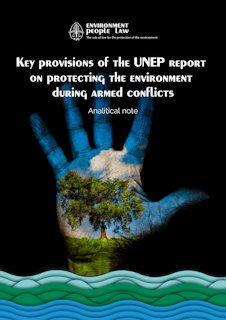 This material contains an analysis of the 2009 UNEP report on protecting the environment during armed conflict, which is available at the following link:https://bit.ly/3GOWvXt.
This material contains an analysis of the 2009 UNEP report on protecting the environment during armed conflict, which is available at the following link:https://bit.ly/3GOWvXt.
This report provides an inventory and analysis of legal provisions contained in four major bodies of international law that can be used to strengthen the legal protection of the environment in wartime. It provides specific recommendations for steps to be taken by various international and national actors to ensure the expansion, implementation and enforcement of a more effective legal framework for environmental protection during international and non–international armed conflicts.
Regarding treaty law. Articles 35 and 55 of Additional Protocol I to the 14 Geneva Conventions do not provide effective protection of the environment during armed conflict due to the stringent and imprecise threshold required to demonstrate damage.
While these two articles prohibit “widespread, lng–term and severe” damage to the environment, all three conditions must be proven for a violation to occur. In practice, this triple cumulative standard is nearly impossible to achieve, particularly given the imprecise definitions of the terms “widespread,” “long–term,” and “severe.”
Support us
- Просвітницька діяльність / Консультації
- Адміністративна реформа у сфері охорони навколишнього природного середовища
- Біорізноманіття
- State management in the field of environmental protection
- Application for protection of rights in court
- Green areas
- Water objects
- Ecological safety
- Pesticides
- Objects of increased environmental hazard
- Establishment and operation of NGOs, labor relations in NGOs
- Access to information
- Climate change
- Soil
- Environmental education
- GUTA
- Workshops and conferences
- Ecoanalytics
- Library
- Links
- Our Publications
- Our infographics
- Presentations of the international conference
- Environment People Law Journal
Key provisions of the UNEP report on protecting the environment during armed conflicts
18 January 2023
Attachments:
- pdf
Key provisions of the UNEP report on protecting the environment during armed conflicts (Ukr)
ReadDownload - pdf

